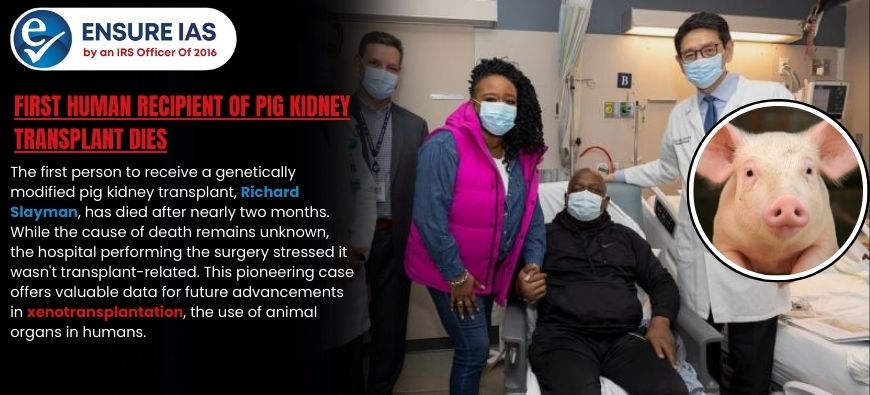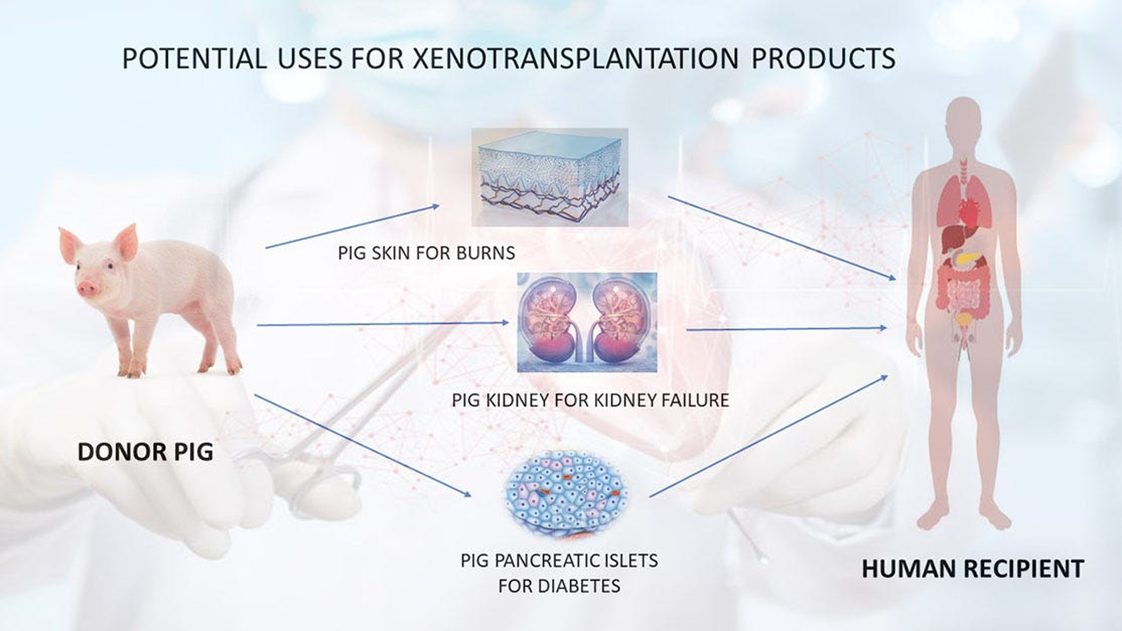- Courses
- GS Full Course 1 Year
- GS Full Course 2 Year
- GS Full Course 3 Year
- GS Full Course Till Selection
- CSAT
- 5 LAYERED ARJUNA Mentorship
- Public Administration Optional
- Online Program
- GS Recorded Course
- NCERT Batch
- Polity Module Course
- Geography Module Course
- Economy Module Course
- AMAC Module Course
- Modern India, Post Independence & World History Module Course
- Environment Module Course
- Governance Module Course
- Science & Tech. Module Course
- International Relations and Internal Security Module Course
- Disaster Management Module Course
- Ethics Module Course
- Essay Module Course
- Current Affairs Module Course
- ABOUT US
- OUR TOPPERS
- TEST SERIES
- FREE STUDY MATERIAL
- VIDEOS
- CONTACT US
First Human Recipient of Pig Kidney Transplant Dies
First Human Recipient of Pig Kidney Transplant Dies
17-05-2024

The 1st recipient of a modified pig kidney transplant passed away on Saturday (May 11), around two months after the surgery was carried out.

- The family members of 62-year-old Richard “Rick” Slayman and the Massachusetts General Hospital, where the procedure was performed, did not link the transplant operation to his death.
About Xenotransplantation:
- Xenotransplantation is the process of transplanting, implanting, or infusing live cells, tissues, or organs from a nonhuman animal into a human.
- It can also refer to the infusion of human body fluids, cells, tissues, or organs that have come into contact with nonhuman animal cells, tissues, or organs
- The first human xenotransplantation involving the heart was attempted in the 1980s.
- The animal organ chosen for transplantation must undergo genetic modifications to prevent the human body from rejecting it.
- After the xenotransplantation, the recipient's body must be constantly monitored to check how it is responding to the organ.
Why is pig often used for Xenotransplantation?
- Pig heart valves have been successfully used to replace damaged valves in humans for over 50 years.
- The anatomical and physiological characteristics of pigs are comparable to those of humans, making them a suitable source for organ transplantation.
- The widespread and cost-effective breeding of pigs on farms provides a sustainable supply of organs for transplantation.
- Additionally, the availability of various pig breeds allows for matching the size of harvested organs to the specific needs of human recipients.
- In January 2022, an achievement was made with the first successful xenotransplantation of a genetically modified pig heart into a human patient.
What is CRISPR?
- CRISPR (pronounced "crisper") stands for Clustered Regularly Interspaced Short Palindromic Repeats. It's a revolutionary gene-editing technology that gives scientists the ability to precisely alter an organism's DNA.
- In simple terms, CRISPR is like a pair of molecular scissors that can cut DNA at specific locations, allowing scientists to remove, add, or change sections of the genetic code.
- This has the potential to cure genetic diseases, develop new treatments for illnesses, create more resilient crops, and even modify the traits of organisms.
How does it work?
- Guide RNA: CRISPR uses a guide RNA molecule to find the specific location in the DNA where it needs to make a cut.
- Cas9 Enzyme: This is the "scissors" part of the system. The Cas9 enzyme binds to the guide RNA and makes a precise cut in the DNA.
- DNA Repair: The cell's natural repair mechanisms are activated, either rejoining the cut ends of the DNA or inserting a new piece of DNA.
Potential Applications:
- Medicine: Curing genetic diseases, developing new cancer therapies, and creating organs for transplant.
- Agriculture: Creating crops that are resistant to pests and diseases, and improving their nutritional value.
- Research: Studying gene function and developing new models for disease research.
- Biotechnology: Creating new biofuels and industrial products.
Ethical Concerns:
The potential of CRISPR technology raises significant ethical questions, particularly regarding its use in humans. The possibility of altering the human germline (the DNA that is passed onto future generations) raises concerns about unintended consequences and the potential for creating "designer babies."
Current Status:
CRISPR is still a relatively new technology, and much research is ongoing to understand its full potential and risks. However, it has already shown promising results in laboratory and clinical trials, and it has the potential to revolutionise many fields of science and medicine.



